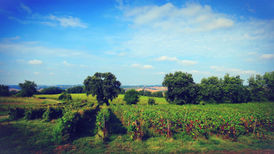HISTORY
 Overlooking Lectoure1930's (photo Ray. Delvert) |  Napoléon cadastre (1824)The estate and its surroundings |  Estate map1961 |  Eastern façade in the late 60's(photo Léo Barbé) |  Original 18th century planThe main building |
|---|---|---|---|---|
 Exterior decorative feature(photo Léo Barbé) |  Napoléon cadastre (1824)"castle and farmhouse" |  18th century outbuildingStables and cellars (photo Léo Barbé) |  Original 18th century planService quarters and the "outside" |  18th century dovecote and wellDovecote now disappeared (drawing B. Comte) |
 Exterior decorative featureM. de Paris-Vacquié's coat of arms (photo Léo Barbé) |
Château de Vacquié overlooks the historic town of Lectoure, which is considered one of the most beautiful villages in Gascony and was once a Gallo-Roman oppidum and former capital of the Counts of Armagnac. Vacquié's cut-stone manor-house was built in 1784 by the Count de Paris-Vacquié, residing in the middle of a 65-hectare (160 acres) estate dedicated to wine making since the 3rd century A.D. The vineyard was a privileged supplier of the French monarchy in the 11th century. Nowadays, Château de Vacquié remains a reference for its excellent terroirs.
In 1986, Bruno & Sylvie Compagnon purchased Château de Vacquié (also known as Domaine de Bacqué), which by that time had become a prune and apple farm because the Phylloxera disease had wiped out a vast majority of the vineyards in the area in the late 19th century. As other places had replanted and rebuilt, the sub region of Haut-Armagnac had transitioned into cereals and fruit orchards leaving the market empty of Haut-Armagnac. Although the family had become one of the largest producers of “Pruneaux d’Agen”, the irreductible Bruno Compagnon decided to replant the vineyards of Vacquié in 1990 to recreate the Haut-Armagnac that had disappeared from production, eventually returning the entire estate to its original plantation as a vineyard. In 1997, the Ministry of Agriculture awarded Bruno Compagnon the “Mérite Agricole” for reintroducing Haut-Armagnac. Since then, the family has carried on its traditions with dedication and respect for the exceptional terroirs and age-old savoir faire (know-how) of the property.
Since 2008, the Compagnons have converted the vineyards of Château de Vacquié into a fully organic estate. In 2011, a solar farm was created allowing full sustainability.
TERROIR
 Armagnac sub-regions (1857)Armagnac & wines from Gascony |  Napoléon cadastre (1824)Lectoure and "Bacqué Château" |
|---|
“The soil of Haut-Armagnac is of superior quality to that of other regions in no small part to it being made up completely of limestone”. Source Gallica, The Wines of the Gers and the Eaux-de-Vie of Armagnac by M.J. Seillan, Secretary of the Mirande Agriculture Society, Member of the Gers Agriculture and Horticulture Society, 1859
Climate: the Mediterranean's influences are tempered with southerly winds thanks to the Pyrenées mountains with mild sunny autumns allowing the sun to shine ideally when the grapes mature.
Orientation: entirely situated on a plateau between 165 meters (540 feet) and 200 meters (655 feet) in altitude, slightly
orientated to the South.
Soil: limestone covered with a thin layer of clay and chalky earth.
-
Armagnac: our Armagnac is made from the traditional noble variety, Ugni Blanc.
-
Wines: our wines are made from the traditional vines of Southwest France : Ugni Blanc, Colombard, Sauvignon Blanc and Gros Manseng for white, Merlot, Tannat and Malbec for red as well as Gamay, Pinot Noir and Syrah adding diversity in our blends.






















